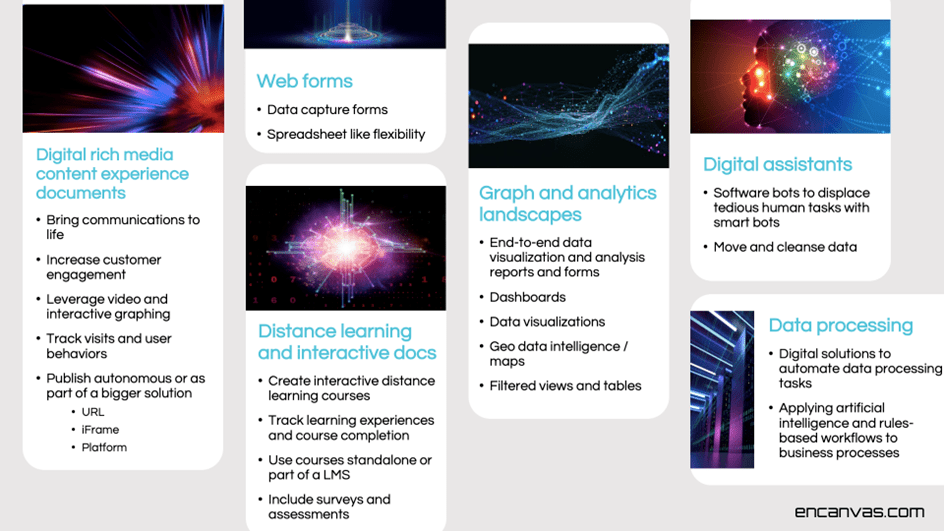Rapid-application development (RAD) is a term used to describe any form of adaptive approach that speeds up the process of creating and deploying software applications.

How digital documents deliver on Gartner’s top 10 data analytics trends

An accelerated pace of change and the need for greater agility is increasing the demand for more consumable analytics. Read our analysis to see how incorporating Digital Documents into your digital strategy is creating digital leaders. Here we look at Gartner’s top 10 data analytics trends to show just how impactful digital documents can be.
1. Smarter, more responsible, scalable AI
According to Gartner, “Smarter, more responsible, scalable AI will enable better learning algorithms, interpretable systems, and shorter time to value. This means that AI technology must be able to operate with less data via “small data” techniques and adaptive machine learning.”
How Digital Documents respond
Digital documents can incorporate third-party code, plug-ins, and integration ware to extend the out-of-the-box design elements provided as standard. Therefore, very pointy problems and fine-grained tasks can be addressed at the edge of the enterprise—at scale. Hence why adopting digital documents sets a smarter and more adaptive balance between IT and ‘the business.’ IT experts can be brought in with high-code or low-code tools to embellish digital documents with artificial intelligence and software bots. Which make decisions, orchestrate workflows, pre-process data, and learn new things from patterns of data, etc.
According to Gartner, “Composing new digital solutions from the packaged business capabilities of each promotes productivity and agility. This is achieved using (served-up) components from multiple data, analytics, and AI solutions for a flexible, user-friendly, and usable experience. Therefore enabling leaders to connect data insights to business actions.”
2. Composable Data and Analytics
According to the Gartner report “Adopt a Composable DXP Strategy to Future-Proof Your Tech Stack,” 60% of mainstream organizations will use the composable business model as a strategic objective by 2023.
How Digital Documents respond
What makes digital documents the ideal substrate for serving up composable data and analytics at the edge of the enterprise comes from their versatility, adaptability, and federated nature. Digital documents respond to growing pressures to offer individuals and departments autonomy and empowerment. While all the time de-skilling technical complexity. However, for most IT leaders, the bigger win is to prevent a potential nightmarish appdev free-for-all as the consumerization of IT extends to citizen developers authoring apps unregulated by IT.
3. Data Fabric is the Foundation
According to Gartner, “As data becomes increasingly complex and digital business accelerates, data fabric is the architecture that will support composable data and analytics and its various components. Data fabric reduces the time for integration design by 30%, deployment by 30%, and maintenance by 70% because the technology designs draw on the ability to use/reuse and combine different data integration styles.”
How Digital Documents respond
Digital document architectures, like Encanvas, rest on a Digital Data Fabric to bring coherency, control, security, and governance. However, most specifically accessibility to quality data for businesspeople. Using digital documents does indeed allow business people to serve themselves with ways to capture, interpret, manage, publish, share, and store information. Of course, these are characteristically the roles performed previously in businesses by hard-copy documents. Combining digital documents with a digital data fabric equips these digital articles with (as Gartner puts it) ‘…the ability to use/reuse and combine different data integration styles.’
4. From Big to Small and Wide Data
According to Gartner, “Smarter, more responsible, scalable AI will enable better learning algorithms, interpretable systems, and shorter time to value. This means that AI technology must be able to operate with less data via “small data” techniques and adaptive machine learning.”
How Digital Documents respond
Pressures for data insights are so numerous, and so adaptive, across any enterprise these days. Hence why no central data analytics repository or capability could ever hope to satisfy all needs all the time. Above all, delivering ‘small data’ solutions widely across the enterprise demands more fluid, yet sublimely joined up and well thought out digital substrates. In a world of platforms and federated systems, digital documents uniquely offer the autonomy and dexterity needed to achieve this. They do this by pushing innovation to the extremities of the enterprise.
5. XOps
According to Gartner, “The goal of XOps (data, machine learning, model, platform) is to achieve efficiencies and economies of scale using DevOps best practices — and to ensure reliability, reusability, and repeatability while reducing the duplication of technology and processes and enabling automation.”
How Digital Documents respond
Should digital documents operate in a similar uncontrolled way as office desktop documents are used today? One can imagine some form of dystopian digital carnage happening across the enterprise. Thankfully, digital document platforms like Encanvas offer a three-tier architecture that contains and fully frames the use of data and digital documents. It means endpoints are protected, permissions are governed, and a higher (not lower) standard of operational control and governance is stamped on enterprise IT architectures.
6. Engineering Decision Intelligence
According to Gartner, “Engineering decision intelligence applies to not just individual decisions, but also to sequences of decisions, grouping them into business processes and even networks of emergent decision making. When combined with composability and common data fabric, this enables organizations to more quickly gain insights needed to drive actions for the business.”
How Digital Documents respond
This serves to emphasize how any useful digital document architecture for the enterprise must reside on a foundational digital data fabric. In the case of Encanvas, digital data fabrics can coexist in digital cloud spaces. With each space being configured and governed by enterprise IT. This enforced balance of power between the governing layer of enterprise IT, and the consumerization of IT made possible by digital documents points to a successful and sustainable approach to information management that is proving to work admirably for digital leaders.
7. Data and Analytics as a Core Business
According to Gartner, “Business leaders are beginning to understand the importance of using data and analytics to accelerate digital business initiatives. Instead of being a secondary focus — completed by a separate team — data and analytics are shifting to a core function. However, business leaders often underestimate the complexities of data and end up missing opportunities.”
How Digital Documents respond
The use of digital documents as a readily accessible (and, as we’ve just covered, highly controlled) consumption layer of composable data allows business leaders to accelerate innovation plans. As Gartner suggests above, decisions surrounding data access, coherency, and quality are being made as part of digital document publishing initiatives across the enterprise. Partly, the success of codeless agile development methods comes from producing live wireframes. These combine real data, so that any data quality shortcomings or shortfalls come to light as digital documents are authored.
8. Graph relates everything
According to Gartner, “as many as 50% of its client inquiries around the topic of AI involve a discussion around the use of graph technology. Graph forms the foundation of modern data and analytics. Although graph technologies are not new to data and analytics, there has been a shift in the thinking around them as organizations identify an increasing number of use cases.”
How Digital Documents respond
Digital documents over unrivaled opportunities to embed sophisticated Graph solutions into rich media articles. One of the technology innovations that makes this possible is HyperDrive from Encanvas. This is a universal data plug that allows IT architects to consume existing applets, plug-ins, data visualization tools, data sources, APIs, and more. Which adds more horsepower to native design tools.
9. The rise of the Augmented Consumer
According to Gartner, “Traditionally, business users were restricted to predefined dashboards and manual data exploration. Often, this meant data and analytics dashboards were restricted to answering predefined questions. Moving forward, Gartner believes these dashboards will be replaced with automated, conversational, mobile, and dynamically generated insights customized to a user’s needs and delivered to their point of consumption.”
How Digital Documents respond
Digital documents are the ideal digital construct to support fine-grained consumer-driven analytics personalized to the action insight needs of the department or user. One of the bigger opportunities for digital documents moving forward is their role in facilitating curiosity across the enterprise. Additionally, to source answers to new questions as they emerge.
10. D&A at the Edge
According to Gartner, “As more data analytics technologies begin to live outside of the traditional data center and cloud environments, they’re moving closer to the physical assets, reducing or eliminating latency. Shifting data and analytics to the edge will open opportunities for data teams to scale capabilities and extend impact into different parts of the business. It can also provide solutions for situations where data can’t be removed from specific geographies for legal or regulatory reasons.”
How Digital Documents respond
Digital documents are the ideal digital construct to federate and democratize data analytics. Which in turn provides access to rich data analysis at the point of use.
Final thoughts—The Top Line
In summary, it is the known ambition of organizations to live and breathe digital and to augment people and decisions through actionable data insights. This is to attain the win. Win of (1) maximizing customer experience and personalization while applying hyper-automation methods and tools to lower service costs through automation.
As part of this agenda, Gartner points to the need for information systems that serve as a great opportunity for business leaders and decision-makers. It allows them to serve up their own fine-grained insights by having greater empowerment.
Fundamental to this newly empowered digital cultural philosophy is the ability to embrace new technologies in an active, dynamic, data-rich environment characterized by composable data gathered and consumed on the edge of the enterprise ‘where business happens.’
Documents, once the operational cornerstone of every business have come full circle with new digital document constructs. Today, as before, they are the workhorse glueware needed to bridge across systems, departments, and organizations. Which equips business people to build, personalize, tailor, apply and orchestrate communications and business processes without deep technical skills.
Digital documents deliver:
- The optimal balance of accessibility—thanks to their codeless make-up that de-skills authoring and management.
- Agility—served up through rapid time-to-value and ease of change.
- Enterprise-grade coherency—operating as they do across a digital data fabric that ensures deployed digital document solutions satisfy scalability, data governance, cybersecurity, and operational effectiveness qualifiers.





 This document highlights five major reasons to invest in an enterprise platform like Encanvas that supports the lifecycle of digital documents.
This document highlights five major reasons to invest in an enterprise platform like Encanvas that supports the lifecycle of digital documents.